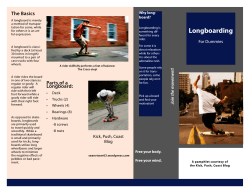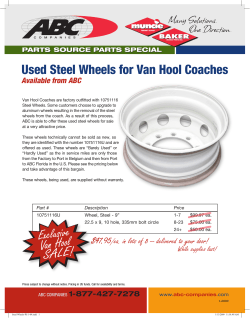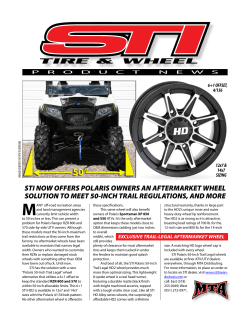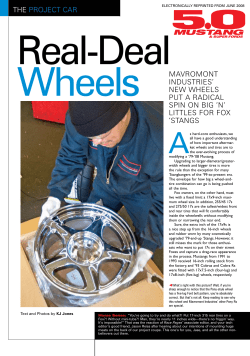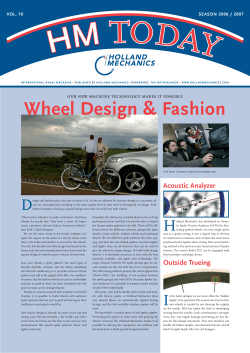
Liam Morgan Photo: Dustin Damron/Caliber
Liam Morgan Photo: Dustin Damron/Caliber GREETINGS LONGBOARDERS! Welcome to the first edition of the Pocket Guide to Longboarding brought to you by Concrete Wave Magazine and S&J Sales. This mini-magazine has been designed especially for those who are new to longboarding. If you’ve got questions, we’ve got answers! Over the past several years, longboarding has exploded in popularity. The reasons are many, but the bottom line is that longboarding appeals to a huge number of people because anyone can pick up and learn to ride, regardless of age or skill level. A large portion of the growth is due to the advantages of a board while commuting. A longboard has larger softer wheels that will roll longer and smoother, giving a much different ride than a typical street board. The other major advantage is the fact that a longboard is much less bulky than a bike, meaning it can be taken onto busses, the subway and even into class. The other areas of the sport that have grown rapidly are downhill and freeriding. With all the development in gear recently riders are now doing things that would have been previously thought impossible on a longboard. As you get better acquainted with the world of longboarding, you’ll soon discover a wide range of products that provide different riding experiences. We encourage you to try these various setups. Eventually, you’ll find yourself building a quiver of boards. No matter the type of terrain you find yourself on, you’ll have the right board. Every facet of longboarding is still growing and developing every year; more people are jumping on a longer, smoother cruising board, and getting hooked. Enjoy this guide, and remember to always put safety first. For more information on longboarding, check out concretewavemagazine.com and golongboarding.ca. TYPES OF LONGBOARDING • CARVE/CRUISE/COMMUTE Carving and cruising are the most widespread forms of longboarding. This is more about using a longboard as a fun way to commute from point A to B rather than seeing how fast you can go. The greatest thing about carving up the asphalt with a longboard is that you don’t need surf, snow or even a lift ticket. You just open up your door and go! Recommended Decks: Loaded, Madrid, Dregs Recommended Wheels: Orangatang, Lush, Dregs • FREERIDING/SLIDING Freeriding takes things up a notch from merely cruising or carving. Freeriding usually keeps the rider going slower than straight bombing a hill. Freeriding is about flow and style and performing every type of slide possible. Freeride boards are usually set up to turn a lot, and slide easy. They feature symmetrical shapes most of the time for riding in switch (riding backwards with tail facing downhill), and are usually set up with round lip wheels to help the board get sideways. Recommended Decks: Loaded, Comet, Kebbek Recommended Wheels: Orangatang Freerides, Cult Classic, Kebbek Libres • DOWNHILL Downhill racing is about being the first person to the bottom of the hill, and ensuring you have a lot of fun doing it. You need a deck that is stable at high speeds with no flex. It’s also vital that you wear all safety gear – not just a helmet. Most serious downhillers have a full leather suit. For information about racing, make sure you visit igsaworldcup.com. Decks we recommend: Kebbek, Comet, Lush Recommended Wheels: Cult Death Ray, Kebbek Magnet, Orangatang Stimulus • SLALOM While technically, not a longboard, slalom has carved out its own place within the world of longboarding. The reason is simple. If you love speed and the feeling of carving with precision, then you’ll enjoy whipping through cones. Slalom has deep roots within skateboarding and thanks to cutting edge technology, there is a whole new generation of coneheads out there. FAQ What is a top mount? The simplest of all mounting styles, the board just simply sits atop the trucks like on normal skate deck. The advantages to a top mount come because it keeps the riders weight and feet over the wheels. This allows the rider to have maximum control and leverage over the trucks. Topmounts have emerged as a trend lately especially ones that are smaller and have a shorter wheelbase. Topmounts function as great downhill race boards because of the grip, but people have been using them for freeride lately which is also popular. What is a dropped board? A dropped board means the riding platform (the part of the deck the rider stands on) is sunk below the trucks. It’s not to be confused with the drop through mounting, although creates a similar feeling by lowering the ride height to help riders feel locked in. Dropped boards are better for pushing because your lower to the ground and for freeriding because they slide longer because of the lower center of gravity. A dropped board will still function great for Downhill too. What is drop-through mounting? Drop through mounting lowers the ride height similar to a dropped board but in a different way. A drop through board is machined out so the trucks mount from the top. This is done by separating the hanger from the base plate. You then mount the base plate into the board from the top, followed by the hangar from underneath. Drop through boards tend to come mostly symmetrical in shape so that riders can ride better in switch. Usually sits around 0.5-1” lower when mounted in a drop through style, makes the board more drifty and good for sliding. I want a board that is fun to cruise on. What should I be looking for? Longboards come in many different shapes and styles, but also different thicknesses and materials. As a general rule if it has a lot of flex, the board was designed more to carve and cruise. Flex in the board allows for a snappy quick feeling carve and is great for commuting and bobbing and weaving between people on a sidewalk. Most boards that feature flex are made of bamboo or a bamboo composite combination. Boards are usually offered with different levels of flex, so that it can be tailored to the person’s weight and preference. BOARD MATERIALS Maple - Maple is probably the most common board material right now, because of its availability, price and durability. Maple creates a very stiff feeling board because of its rigidity and thickness. A maple board will also last an extremely long time and should be able to hold up to even the hardest of skateboarding. Bamboo - Bamboo is becoming a more common board building material in the longboard world. Bamboo has much more flex and resilience than maple. Bamboo boards are more for carving and cruising because they have so much flex. Bamboo is usually used in combination with fiberglass to help hold the board together under the stress of a skater. A bamboo board is usually not very thick in comparison to a maple deck, but this creates a board which is easier to carry around when not in use. Carbon Fiber - Carbon Fiber is the most expensive option for a longboard composite, but brings advantages to the table. Carbon boards are very light and usually have foam core to help lighten the weight. Carbon is usually used to wrap another medium to make it stronger, a lighter board makes for a faster push off the start line and makes it easier to move around in slides. Carbon Fiber is more for an experienced rider, because it takes time to learn a board well enough to appreciate the feel of carbon fiber. TRUCKS Longboard trucks are very different than regular street skating trucks. A Longboard Truck is known as a “reverse kingpin” truck, because the axel is on the other side of the kingpin compared to a standard truck. A longboard truck has lots of lean which creates the deep smooth feeling carves which longboarders crave. Reverse Kingpin trucks are affected by many different factors, and knowing which trucks will go good with which board and style of riding is the key to a proper setup. a higher angle will allow for more turn. A 50* Base plate will also make the setup slightly taller than a 40-45* baseplates. A 50* base plate is the standard for longboarding, fifty degrees is a great all around base plate because it turns enough for cruising but still has some stability for downhill. While a lower angle will be better for stability because it has less ability to turn. This works great for downhill but can take away some of the fun of a board when it doesn’t turn sharply for cruising. Most downhillers will run a 42* or 44* base plate with a 180mm hanger. WHEELS Hangar Width When selecting which truck is right for which board you must first consider a couple things. The first of these is the width of the hanger. The hanger width is meant to be matched to the width of the board. A 9”wide deck or greater will need a minimum of 180mmm Hanger width. With less hanger width the wheels are more likely to come into contact with the board during sharp turns and stop it suddenly because of wheel bite. Decks that are not as wide can get away with the sharper turning 150mm trucks as they are designed more for smaller cruising boards and minis. Baseplate Angle Base plate angle also affects the way in which a truck will turn; a lower base plate angle will make the truck turn less, while The magic of longboarding comes together with the wheels. It’s crucial that you utilize the correct wheels, because they can make a huge difference in your riding experiences. Durometeris a measurement system for Urethane that measures its hardness. The lower the number means the softer the wheel will be. An extremely soft wheel will grip the pavement better through turns because the urethane is stickier, although they may roll slightly slower and not slide as smoothly because they are soft. A hard longboard wheel will be around an 83-86 durometer. These wheels will roll faster, grip less, and chatter less in slides. This is because a harder wheel has a higher roll speed and less rippling in the urethane when sliding. WHEEL SHAPE Wheels that have rounded edges are usually designed as a freeride/sliding based wheel. A rounded lip allows the wheel to break sideways into slides easier which is what someone who is interested in sliding and learning to slide is looking for. Rounded lips tend to not be good as a racing wheel because the rounded edges don’t promote grip through turns. A rounded lip wheel will work well for a person who is commuting as they don’t need lots of grip. Wheels that have sharper edges rather than a smooth round lip are usually designed more for maximum grip and racing. A hard lipped wheel doesn’t break traction as easily as its slippery counterparts. That doesn’t mean that wheels with hard lips can’t slide or be used for freeride. They are just harder to break into a slide. Hard lipped wheels are great for racers who will know exactly which model and hardness they would like. WATCH OUT FOR WHEEL BITE! This happens when a turn causes a wheel to collide with the board, usually resulting in the board suddenly stopping. It’s something that you should test for, before riding any board. There are a few ways to prevent this from happening. The simplest is to keep the kingpin tight enough to prevent the hanger from leaning far enough for it to bite. The other easy solution is to have a few risers in between the trucks and deck. You can also purchase smaller wheels. LONGBOARDING 101 WHAT’S THAT SKATEBOARD FOR? SILVERFISH LONGBOARDING’S GUIDE TO BOARDS AND DISCIPLINES Skateboarding defies definition to many, but if you’re just getting into longboarding or classic skateboarding, you might be blown away by the variety of purpose-built styles and construction for skateboards. It’s not all popsicle sticks and teeny wheels, right?! So, here’s a quick and general guide to the basic categories of boards and the disciplines they’re designed for. None of this means you can’t skate anything, anywhere, but for those of you wanting to figure out what all those terms mean in the rest of the Buyer’s Guide, here’s a look at the general disciplines and some iconic shapes and setups you might recognize… FREERIDING – a term used to describe any style of skating downhill that includes drifting, sliding, hard carves and aggressive maneuvers. Any board a skater is comfortable with that affords the handling and agility can work for a freeride board. However, the current standard is a bidirectional board with deep wheel wells or cutouts and often drop-through mounted trucks of either “conventional” or “inverted” style. This is the style that varies with you, but generally involves wheels intended for sliding and thrashing, typically 70-76mm in diameter, and 78A-89A durometer. SPEEDBOARDING – the sport of getting down a hill as fast as possible. Standard downhill (or “DH”) decks are rigid for stability, with moderate concave, no kicktail and lengths typically ranging from 36” to 46”. Inverted-style trucks are used, in drop-through and top-mount configurations with wheels 70-100mm in diameter and 78A-89A durometer. Look for designs intended to eliminate wheelbite, and prepare to encounter the most exotic of materials ranging from maple to monocoque composites. SLALOM – usually a timed sport that involves avoiding cones either on flat land with small spacing (tight), downhill with more varied spacing (hybrid) or steeply downhill with large, spread-out spacing (giant). Most slalom boards range in size related to the style of slalom, from 30” to 36”; utilize asymmetrical concave (more in front) with a nonfunctional kicktail or footrest at the back and toe-stops on the front of hardcore race boards. The standard is for “wedged,” conventional trucks and 65-77mm wheels with durometers ranging 77A-85A. CRUISING – traveling from one location to another in whatever manner the skater sees fit. Any board can be a cruiser, and this term is also used by street skaters to describe any board with “soft wheels.” Cruiser boards tend to be medium to larger-sized boards, often with wide shapes that allow many foot positions. Wheels and trucks are based on rider preference, but are often inverted-kingpin trucks with wheels to fit the board in a low to medium durometer. Soft wheels and great turning ability are the hallmark of a campus cruiser and general fun-hog longboard. CARVING – the manner of riding a hill where the skater cuts back and forth in hard turns to scrub off speed and yet maintain control of the board, very much like surfing. Carving boards are often set up for maximum turning and allow the trucks and wheels to turn as deeply as possible, with typical board lengths over 36”. Flexible decks are popular but not required. Inverted trucks and high-traction design wheels with durometers 75A-85A are typical setups. LONG DISTANCE – a growing style, broken into two groups: Long Distance Skating, where the focus is the actual pushing over great distances, and Long Distance Pumping, where the focus is generating momentum by pumping. LDS boards typically have a “dropped deck” for extra-low height to the road, and LDP boards are often similar in shape to slalom boards, yet slightly longer. Wheel diameters typically run 70-76mm and durometers range from 77A-84A, depending on the setup and riding style chosen by the skater. BOARDWALKING – also called “dancing,” this freestyle skating focuses the upon the skater’s ability to use the deck to accomplish tricks and maneuvers on the deck. Boards are typically 40” to 60” and may have concave and a kicked nose or tail. Wheels and trucks are often set up so the board’s agility is easily controlled by the rider and wheelbite is impossible, and smoothness is ensured via wheel diameters 70-76mm, durometers in the 77A-84A range and pretty much any truck you like, either conventional or inverted. TECHNICAL SLIDING – a specialized discipline with some crossover to street-skating gear, this is the intentional breaking of traction on steep hills to accomplish tricks that modify the board’s movement down the fall line. Much more than “power sliding,” these tricks can include stalls, rotations and the use of gloves with pucks for hand-onthe-pavement moves. The decks are usually 34” to 38” with twin kicks and hard, smaller wheels on conventional trucks, but a variation growing in popularity (see “freeriding”) uses 70mm or larger “soft wheels.” OK, that’s a quick look at some of the general disciplines and skateboard styles active within longboarding and classic skateboarding. With experience, you’ll learn how variations on these themes suit you and your terrain perfectly, but this should give you a great start. If you’d like more information or input, jump on over to SILVERFISH LONGBOARDING.COM. There are forums for “Beginner Q/A” along with discussion areas for each of these disciplines, and much more. By the skaters, for the skaters, it’s the largest online skateboard community on the Internet, and it’s the place to check in when you’re not out shredding the concrete waves. See you out there! Safely out in front is Mason Ferick, followed by Ben Ramsey. Photo: Jozy Brink. SURVEY SAYS: SAFETY at SPEED By MIKE MAHONEY I t calls your name; it teases you in your dreams. You know the hill – the one that eludes you, the one that keeps you up at night, the next one on your list to bomb. We all have a new hill in our sights, and when you tame it there’s always another, begging to taste your urethane as you tuck, drift and slide your way from that dream into reality. When everything clicks, time seems to stop. The asphalt is a blur under your feet; it feels effortless. Something magical happens, and the stoke you feel lasts for days. Leading up to this magical event, your mind dances with thoughts: How fast will this hill take me? What board, wheels, bushings should I use? You start to compile a mental list: Standard helmet or full-face? Leathers or pads? Who will I share this with? Can I make that hairpin? Speed check here, drift that corner, stay left to avoid pothole... We seek that feel of the stoke and the hill that will serve it up. We also want to be able to order up another plate of stoke tomorrow. There are many variables to consider when riding a hill at speed, some of which you control and others you don’t. Before each and every speed run you should inspect your equipment. Look for cracks or delamination of your board. Small stress cracks around the mounting bolts aren’t a concern unless they penetrate more than one layer. If you are one who changes your wheels or bushings often, the more you remove the lock nut(s), the less effective the nylon becomes in locking that nut to the axle or kingpin. If you can turn the nut by hand, it’s past time to replace it, otherwise it will vibrate off and the wheel or hanger will follow. While your checking your nuts, check to see if your mounting hardware is tight. If your board is made of wood or has wood in its makeup, it will shrink and swell with the changes in weather and humidity, causing the bolts to loosen. Bushings are a personal choice and should be in good shape with no visible cracks or damage. The same goes for your wheels. Check your wheels for flat spots; the vibration they create will be magnified as your speed increases. Once you have your board in order, pre-run the hill. It doesn’t matter if it’s a new hill or one you’ve run 100 times. Traffic, weather, road work and even people can change the conditions of the course to be run. The goal is to identify “SHARE YOUR STOKE. DON’T RIDE ALONE. WHEN YOU SHARE SOMETHING WITH SOMEONE THAT FEW OTHERS EXPERIENCE, THERE’S A UNIQUE BOND THAT FORMS. WHEN YOU SHARE THE STOKE WITH YOUR MATES YOU’VE ENTERED THE FRATERNITY WE CALL LONGBOARDING.” obstacles so they can easily be avoided. This can be done by first driving the hill or by walking it to closely inspect the surface conditions. Make note of traffic, parked cars, blind corners, driveways and side roads that cars may unexpectedly pull out of. Loose gravel, rocks, cracks, wet areas and potholes are especially troublesome. Remove what you can and learn to avoid the rest. Look for run-out areas or places you can quickly shut it down if needed. Position spotters at blind corners and side streets to alert you of oncoming traffic. The faster you run a hill, the quicker you need to be able to react; pre-running a hill can buy you those lost seconds you may need. The thrill that speed provides is the drug the hill is pushing. Controlling your speed is vital to managing your risks. You should be able to footbrake, slide/speed check and body/airbrake at a moment’s notice. Everyone has a maximum speed that they are comfortable with; know what yours is. This “comfortable” speed is one you are able to stop safely from. It’s good to push your limits – that’s how we improve. If you know where that line is, you can push yourself to it, step one foot over and be able to get back. The speed you’re comfortable with is different around a corner than it is on the straights. On a new hill it’s a good idea to take the first run slow and increase your speed with each run until you find the “line.” Practicing your sliding and drifting techniques will help you manage your speed on the hill. Speed wobbles are never a good thing, and you should learn how to avoid and deal with them if they rear their ugly head (see article in previous issue). Your shoes should be in good shape and well secured in case you need to footbrake; leave the loafers and flip-flops at home. Share your stoke. Don’t ride alone. When you share something with someone that few others experience, there’s a unique bond that forms. When you share the stoke with your mates you’ve entered the fraternity we call longboarding. Ride with someone who is predictable. Learn where their comfort zone is, how each they approach a turn, how they slide and stop. Communication is critical. Take a page from the Lycra-wearing, leg-shaving road cyclists and use hand signals. Develop a system of hand signals where you can notify riders behind you of an obstacle, traffic, a hard corner or when you’re going to throw down a slide or stop. This is good for the spotters to use as well. You’re not going to be able to hear a spotter or another rider with the wind howling in your ears as it forces the skin on your face tight, making you look like you just had Botox injections. Speaking of hearing, I know many of you like to ride to your favorite tunes. Leave the headphones in the car. You want to be able to hear someone approaching from behind or from around the corner. I have come up on people wearing headphones and scared the s**t out if them because they could not hear me – even when I called out or yelled. Justin Rouleau. Photo: Jay Vonesh All this is for naught if you don’t take some basic precautions. A helmet, pads and gloves should be the minimum safety gear used when riding hills at speed. Typical skate helmets are not designed to take a fall at high speeds. As you become faster, you will want to look into a full-face helmet and a pair of leathers. Keep in mind that drivers and pedestrians are not expecting to see you on the road. Make yourself as visible as possible. Wear bright colors, and stand up when traffic approaches. Check the hill at different times of the day and ride when traffic is at a minimum. You should know whom to call if a buddy gets hurt. Tell someone where you’re riding and when to expect you back. Carry your cell phone and have an ICE (In Case of Emergency) number. Emergency medical personnel know what this is and will look for it if you are unable to communicate. On your journey to find the stoke, you can now approach that hill with confidence, knowing you’re prepared. You can face the challenges the asphalt brings to the table, feast on the stoke and walk away, ready to do it all again tomorrow. Ride Safe! CW DISCLAIMER: This article was written from the responses of more than 400 participants in a survey conducted by Concrete Wave. This article is in no way a complete guide to rider safety. Each circumstance has its own unique challenges, and it is expected that the rider evaluates them and adjusts his/her riding accordingly. Ride within your own ability!
© Copyright 2025
